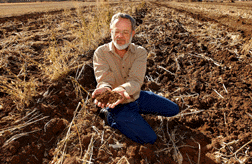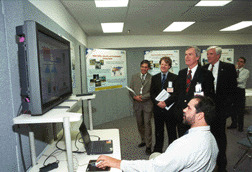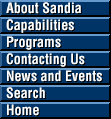FOR IMMEDIATE RELEASE
January 9, 2002
Software tool could help avert water crises, quell geopolitical tensions
Sandia simulator rapidly calculates tomorrow’s water resources given today’s policy choices
|

BETTER WATER MANAGEMENT TOOLS such as Sandia’s Dynamic Water Budget Models migh avert crises in many parts of the world, says model co-developer Dick Thomas of Sandia National Laboratories, seen here in a dry Albuquerque crop field. (Photo by Randy Montoya)
Download 300dpi JPEG image, ‘thomasinfield.jpg’, 1.1MB (Media are welcome to download/publish this image with related news stories.)
|
ALBUQUERQUE, N.M. — Researchers at Sandia National Laboratories have developed software models they think might help not only regions and nations with critical water shortages, but also areas such as the Southwestern U.S. where sound water management policies might avert a crisis.
The computer simulations, called Dynamic Water Budget Models, allow decision makers to see how water policy options selected today would affect a society’s water resources decades into the future.
The models are based on commercially available simulation software Sandia has used to study everything from summer blackouts in California to global nuclear material inventories.
Test driving water policy options is as simple as fiddling with a few knobs, says Dick Thomas, one of the Sandia creators. The research simulations provide immediate extrapolation and visualization of results.
Each model is a complex representation of the subtle interrelationships among ground and surface water sources, recharge rates, groundwater pumping, irrigation, climate, evapotranspiration, and demographics. Future models will include other factors, such as environmental impacts, water quality, economic productivity, and an area’s social and cultural foundations.
“The models ask what the water resource picture might be 20 years down the road given today’s choices,” says Thomas. “This is the only model we’ve found that allows for big-picture, long-term planning.”

Sandia National Laboratories co-developer Steve Conrad (sitting) demonstrates the Middle Rio Grande Dynamic Water Budget Model to Sen. Jeff Bingaman (D-N.M.) during a recent visit to Sandia.
Download 300dpi JPEG image, ‘conradatcomputer.jpg’, 280K (Media are welcome to download/publish this image with related news stories.)
|
|
Sandia built the first water model in the mid 1990s to examine water trends for China’s 10 major water basins, concluding that water will become a limiting factor in the country’s ability to feed itself during the next two decades as China’s major agricultural areas run increasingly large water deficits. The simulations were part of a Harvard University study that helped alter the way some experts now think about China’s future.
According to the National Intelligence Council’s “Global Trends 2015” report, half the world’s population will lack access to fresh water by 2015. Scarcity of resources is a primary cause of geopolitical tension in many regions of the world, it says.
“We must do something now to prevent water resources from instigating political instability, or prepare for the inevitability of conflict over water,” says Sandia co-developer Steve Conrad. “It is in our interest to help these governments plan their own futures.”
The team next used the Middle Rio Grande Basin, the primary water supply for the Albuquerque, N.M., metropolitan area, to develop the tool further.
“It’s a way of helping our community with sustainability issues while also creating a tool that could help the nation and the world,” says Thomas.
The team continues to work with city and state officials to apply the tool to Albuquerque-area policy making efforts.
A similar model of another water basin in rural northern New Mexico is helping farmers and developers see the possible results of various development schemes and agricultural practices.
“Different users have different ideas about what optimal use of the water resource is,” says Thomas. “We helped get them talking sooner about realistic approaches rather than dwelling on unworkable, unsustainable options.”
They now are exploring the possibility of modeling water issues for basins shared by countries of the Former Soviet Union, for nine countries that border the Nile River, and for the U.S. and Mexico in the El Paso/Cuidad Juarez border area.
“Anybody can play their own ‘what if’ game,” says Conrad. “It allows people with different stakes in the outcome to rapidly test the long-term effects of policy options. It’s very democratizing.”
Sandia is a multiprogram laboratory operated by Sandia Corporation, a Lockheed Martin Company, for the United States Department of Energy under contract DE-AC04-94AL85000. With main facilities in Albuquerque, N.M., and Livermore, Calif., Sandia has major research and development responsibilities in national security, energy and environmental technologies, and economic competitiveness.
Technical contact:
Dick Thomas, dpthoma@sandia.gov, (505) 284-2503
Media contact:
John German, jdgerma@sandia.gov, (505) 844-5199
Related Sandia news releases:
http://www.sandia.gov/media/NewsRel/NR2001/watsniff.htm
http://www.sandia.gov/media/NewsRel/NR2001/watinfr.htm
http://www.sandia.gov/media/NewsRel/NR2001/sanssorb.htm
|
